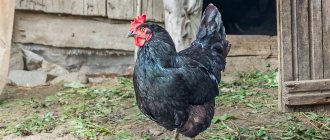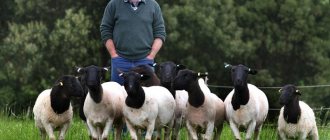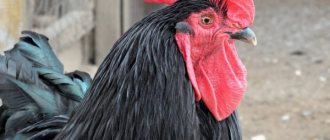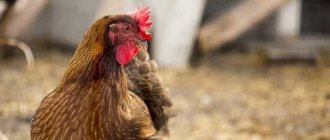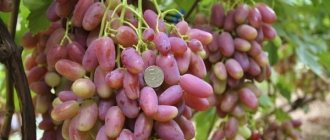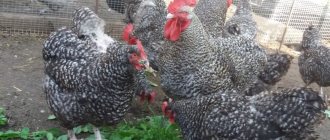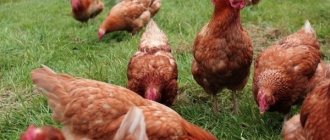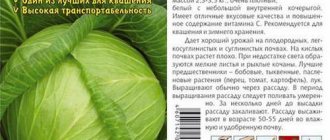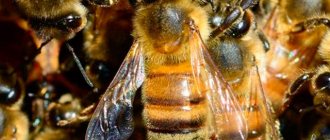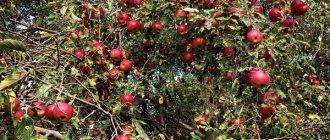History of development
The first mentions of the breed go back to the Ming Dynasty in China. At the end of the last century, the Ukheyilyu almost became extinct. The breeders found the last 2 chickens and 1 rooster in one of the villages in southern China. From that moment on, the revival of the breed began, which took several decades.
In the process of genetic research, it was revealed that the chickens are of natural origin; they were found to have genes from pheasants, Chinese silk chickens and the Yugan breed.
The breed is very rare, it is difficult to find even in China. They are protected by a government program and are listed under the National Germinal Resources Conservation Project. Despite this, birds are found on private farms in our country.
Origin story
The most difficult question is the origin story of “Lakedanzi”. For poultry farmers who want to find out the truth about “Lukedanji”, and at the same time – “Wuheiliu” and all Chinese chickens that lay green eggs, we present only the facts - what is confirmed by documents from official sources, and not by stories from Chinese managers from online stores.
First, about the confusion in names due to the language barrier:
- “Wuheiliu” is the word for color in Chinese. That is, in this context - the color of the feathers, without indicating the breed of chickens.
- "Wuheiliu" is a silver-edged color related to the "Lakedanzi" or "Lukeidanji" breed.
The next disappointment is in the name of the “breed”.
"Lukeidanji" or "Lakedanzi" is a phrase that refers to all varieties of chickens in China that lay green-shelled eggs. There are about twenty varieties of them.
We'll talk about the green color of the shell below. In the meantime, let’s talk about the breed and the myths associated with it.
Myth one
According to legend, the “Lakedanzi” or “Wuheiliu” breed was described in a scientific treatise by the Ming Dynasty court healer, Li Shijen, 1300 years ago.
Rhetorical question: how many Russians will be able to understand all modern forms of the Chinese language or read and fluently translate “The Tale of Bygone Years” from Old Church Slavonic? That's the thing, it's not much.
But the truth about green chicken eggs (绿鸡蛋 ( Lǜ jīdàn )) “lies on the surface”: wild and domesticated birds that build nests on the ground lay colored eggs for camouflage, and this is the result of natural selection in nature, and not breeding work , which no one dealt with during the Ming Dynasty.
Myth two
1,300 years ago, bird domestication had just begun. The ancestors of all modern chicken breeds were and remain pheasants - representatives of the Pheasant family, the order Galliformes, which, according to the modern classification, includes all breeds of domestic chickens.
It is not difficult to explain where the myth came from that “Lakedanzi” and “Uheyiliu” were bred by crossing a pheasant and a bank jungle fowl. By the way, both of them have long lived in the territory of Southern China, where the legend about chickens of the “Lakedanzi and Uheiliu breeds” was born.
Take a closer look at the image: this is a bank junglefowl (female), a regional species found in Southeast Asia.
Bankivka junglefowl (female)
And this is what the famous “Lakedanzi” looks like:
Lakedanzi
And one more variety, common in China and for a long time all over the world: the decorative dwarf breed Bantamka.
Decorative dwarf breed Bantamka
Where the pheasants came from in the Chinese version is, again, explained by linguistic confusion.
Pay attention to the hieroglyphs highlighted in red:
野鸡 -pheasant (Yějī)
母鸡 – wild chicken (Mǔjī)
Graphically it looks absolutely the same: for Russian poultry fans it’s practically the same thing, for fellow Chinese entrepreneurs sending tons of special cargo to Russia it’s a marketing ploy.
Be sure to read:
Weighs like a broiler, but lays like a laying hen - these are Master Gray chickens
Who will reveal trade secrets?
Myth three
Anomalies occur in nature when a female allows a “stranger” (a male pheasant) to approach, but they are extremely rare, and to create a breed, a one-time act and one female is not enough. Authoritative Russian breeders write in textbooks for agricultural universities that to breed a breed you need 25,000 chickens, and not one rooster and two females, accidentally found, by no one knows who, in some village in Southern China.
It is even more strange that the person who “accidentally” discovered the extinct breed in the late 80s of the last century wished to remain anonymous, while every Chinese farmer is now selling the rarest breed of chickens with black meat, black bones, entrails, and feathers to the tribe. and even a comb, earning decent money.
By the way, the description “五黑 (Wǔ hēi) – five black (“Uhei”)” does not apply at all to the “Lakedanzi breed”, as well as to “Uheiliyu”. In the first case, the color of the comb and plumage are far from black, in the second... But this is the next myth about the “breed”.
Myth four
A few more words and the mystery of the origin of the “Lukedanji” will be finally revealed, may our enterprising Chinese comrades forgive us.
The legend of the “unique discovery” of two hens and a rooster points to the village of Dongxiang in Jiangxi Province.
Who was looking for them there and why there?
Let's turn to official sources. After all, a scientific sensation about interspecific crossing, and even with the production of offspring, should be somehow registered, especially since in Internet legends about wonderful chickens, hints of a patent are found on several sites.
In Jiangxi Province, the Academy of Agricultural Sciences and Animal Husbandry has existed since 1975, and therefore the “amazing find” should be recorded in the section on scientific activities. But no patents or copyrights have been found for the discovery or creation of the “Lukedanji” or “Uheiliyu” selection.
A specialist in assessing the reliability of information about goods and contractors, with knowledge of the Chinese language, had difficulty finding in the section “Awards and Prizes 1978-2000.” modest entry No. 211, made in 1998: provincial prize for breeding (not discovery!) Luikedanji Dongxiang.
Breeding lasting 15 years, financed from the state budget, must be reflected in the reports. The patent was discovered in the Yangzhou office, and it contains the essence of the discovery.
It turned out that DW, a gene encoding black plumage and green egg shells, built into the chromosome of the male of local birds, and inherited in a dominant manner, caused so much noise!
Naturally, it was placed for storage in the gene bank of the People's Republic of China, in Yangzhou, as in the largest gene pool of poultry breeds, under number 9357, on September 5, 2009.
The description lists the signs, including black meat and eggs with green shells. There is also information that the plumage contains colored feathers, and this is unfortunate news for poultry farmers who paid a lot of money for a parcel from China and received a “defective” bird. But it's better to find out later than never.
Conclusion: As you can see, there is no clear breed of “Lukedanji” or “Uheyiliu” - it’s all due to the DW gene, which can be transmitted as a dominant one, or may not be transmitted, and at the same time has a number of deviations, which is why so many varieties of these birds have appeared. From all that has been said above, it follows that this is not a “Lukedanzi” or “Ukheilyuy” breed, but only an established name for certain types of birds with the same DW gene and characteristic features.
Characteristics of the breed
The peculiarity of chickens is their color. Translated from Chinese, the name “uheiliu” means 5 black (comb, feathers, skin, bones, meat) and 1 green (eggs). But high-breed chickens are not completely black; they should have a glossy green tint in the plumage and purple in the lobes, comb and front of the head.
Exterior:
- the shape of the body can be described as compact;
- elongated tail;
- developed chest and wings;
- the plumage is thick, under the feathers there is a thick downy cover;
- black skin;
- large black eyes;
- leaf-shaped 5-toothed comb, larger than other breeds;
- earrings are strongly pronounced;
- paws are medium-sized, stable, black-gray in color.
An adult chicken weighs approximately 1.5 kg, a rooster weighs up to 2 kg.
Detailed description of the breed with photos
Chickens laying eggs with green shells, as already mentioned, are not uncommon in China. There are also chickens with black meat and bones - Chinese silky, Ayam Tsemani, Australorp. Chinese breeders are also interested in the achievements of world experience and varieties of “black” chickens.
Be sure to read:
Chickens of the Wyandotte breed - decorative appearance and excellent productivity
The leaf-shaped comb indicates that they belong to the egg-laying breeds, and the characteristic color of the plumage is very similar to jungle bantams. The black-brown meat of Luikedanji does not contradict the genetic prerequisites for breeding Chinese chickens, as do green-shelled eggs. Moreover, the “black” gene was planted in the standard chickens of local breeds.
In the selection experiment, among other breeds, biomaterial (sex cells) of a rare species of wild bantam was used, which was discovered in Jiangxi province during one of the planned “inventories” in the 80s of the last century.
The introduced gene is unstable, and for this reason Russian farmers, already in the second generation, are identifying birds with a violation of the “ear” trait (5 black ones). But the official documents of the PRC gene bank say nothing about black plumage and scallops: they only talk about black meat, bones and green eggs.
This means that Lyukendanji Dongxiang is a hybrid, although it was registered in the largest bank of genetic material of pedigree birds in China, and work on it, for some reason, was not completed.
According to the results of the selection, in which 6 institutes took part, it is clear that the Ukheyilyu breed does not exist at all, since this is one of the possible color variants of the Lakendanzi, the genetic material of which, in its pure, original form, is stored in the gene bank, in China.
Sexual maturity, productivity and taste characteristics
Chickens of this breed are classified as meat-egg breeders, but they do not have high productivity rates.
Sexual maturity is characterized as mid-season - chickens begin to lay eggs at 6-8 months.
Egg production is average, per year one hen lays from 160 to 180 eggs weighing 48-53 g with a large yolk (it is 8% more than that of chickens of other breeds). The maximum number of eggs is obtained in the first year of life.
Productivity is maintained for 2 years, then it decreases.
Meat is of high value because it has a delicate structure and many useful substances.
Due to the rarity of the breed, birds are sent for slaughter in isolated cases.
The healing composition of eggs
Eggs are valued for their high taste and healing composition; they are easily digestible.
The composition of green eggs in large quantities includes:
- vitamins A, E, B;
- selenium;
- iodine;
- zinc;
- lecithin;
- amino acids.
Doctors recommend using them for the following diseases and conditions:
- anorexia;
- pica;
- diseases of the cardiovascular system, during recovery after stroke and heart attack;
- disorders of the thyroid gland, diabetes mellitus;
- hormonal imbalances;
- digestive disorders;
- to lower cholesterol;
- to improve immunity;
- for the harmonious development of the child’s body;
- to slow down aging;
- to replenish protein and collagen reserves in athletes.
The Chinese call Wuheiliu eggs a product for the mind, health, beauty and life.
Dietary supplements are made from egg extract.
Features of raising chickens
Raising chickens of this breed is practically no different from the procreation process of other chickens.
Did you know? At birth, chicks are gray-ashy in color.
During the first 2 months, the chicken gains weight from 500 to 800 g.
For babies to be healthy, it is necessary:
- inject the vaccine into the entire livestock on time;
- monitor the temperature in the place where babies sleep and eat;
- eliminate drafts;
- Your daily diet should include vitamins and clean water.
Chicks are not transported in the first weeks of life, as there is a risk of death. In order for them to be healthy and delight their owner for a long time with their unusual color and many healthy eggs, it is necessary to select high-quality food for them.
Chickens are often fed boiled green eggs from old hens.
This strengthens the babies' immunity. The addition of greens and cottage cheese to the diet is welcome. A month after birth, specialized foods are added to the diet. Ukheiliyu are not picky in their choice of food. They eat little and prefer soft types of food. In winter, food is heated by adding warm broth.
Temperament
The following character traits of black chickens are noted:
- peacefulness - do not conflict with each other and other cohabitants;
- activity - they do not tolerate cage housing, they need walking, they fly well and high;
- tension – hens are somewhat timid and fussy;
- the instinct of family life is developed - they live in groups;
- roosters - keep order well, protect the family only when necessary;
- the bird quickly gets used to its owner, remembers a large number of words, and has high intelligence;
- They cannot stand sharp, loud sounds and screams, as well as cruel treatment, and in such conditions they begin to get sick.
Diet of adult birds
Another area of caring for Chinese quoas that will not cause you problems is nutrition. In fact, a traditional chicken diet suits them, although they prefer to consume soft food. Another advantage is that they eat very little.
Let's look at some feeding tips.
- The nutritional value of the diet should be greater in winter because more energy is expended to maintain a stable body temperature.
- In cold weather, keep the mash warm. Just pour warmed broth or some other liquid over the ingredients.
- Add mineral mixtures to your food daily because blackclubs have a high egg-laying frequency and need calcium.
- It is not recommended to use premixes to improve performance. Firstly, laying hens hardly respond to them, and secondly, they are harmful to health.
- Diversify the menu - use all available types of grains or ready-made combined feeds.
- Greens, tops, vegetables - these products should be in the feeders every day. In winter, they will be replaced by root vegetables, dry grass, and vitamin supplements.
Advantages and disadvantages
Ukheiliyu chickens are of natural origin and have strong immunity. They are able to survive in nature, so they are not demanding on living conditions.
Other advantages of the breed include:
- an unusual type of bird, especially valuable for exotic lovers;
- beneficial properties of eggs and meat;
- disease resistance;
- high survival rate of chicks;
- good adaptation to new conditions.
The disadvantages include:
- rarity of the breed, difficulty in purchasing hatching eggs and chicks;
- low frost resistance;
- after 2 years of life, egg production decreases.
Reviews
Valentina Vladimirovna, Moscow, 42 years old.
Ukheyilyuev meat is very tasty. The taste is somewhat reminiscent of game, but unlike wild poultry, the meat has a more delicate structure and is easier to chew. The chicken is very rare, we also didn’t get it very easily, I personally haven’t seen one of my friends. Productivity is not very good, when compared with crosses, there is not much meat either. But if there is no goal to sell eggs or meat products, then you can keep the bird at home. Both beautiful and tasty. Plus it also eats an order of magnitude less than other breeds.
Anastasia Viktorovna, Moscow, 39 years old.
The breed seems to be new, at least not very common here. Lucky to take it in March 2021. The young started somewhere closer to the 4th month of their life. The eggs are small but tasty. I wouldn’t say that the taste is very different from the taste of ordinary eggs, but there is some other taste. I have been raising the breed for two years now, and so far there have been no problems.
Contents Ukheiliyu
The main criteria for proper maintenance in a household are:
- No drafts and insulation. Build a good-quality chicken coop with thick walls and no cracks for Ukheyiliu chickens. Maintain the temperature in it at 15-17 °C. Both a decrease in this indicator and an increase in it are detrimental to chickens. In winter, install electric heaters or infrared lamps for heating. Maintain air humidity at 60%.
- Floor and bedding. Make the floor covering from wood. Place a thick layer (12-15 cm) of bedding on the floor. Sawdust or straw are suitable for this purpose.
- Ventilation. Install the system so that it does not cause drafts, ensures a constant flow of fresh air, and prevents an increase in humidity.
- Need for a walk. A mandatory condition for keeping Ukheyiliyu is the possibility of free walking.
Chickens should not be kept in cages. During the cold season, provide a sufficiently large area of the chicken coop, additionally equip it with ladders and bridges along which the chickens can move. Birds can be released into the walking yard at a temperature not lower than +2 °C. In windy and rainy weather, it is also better to keep them indoors. - Walking yard. Fence with a high fence and provide shelter from above. This will protect timid chickens from unnecessary anxiety, provide protection during bad weather, and prevent attacks by birds of prey. For the flooring of the walking yard, sow lawn grass.
- Lighting. In winter, turn on the lighting in the chicken coop. Daylight hours should last 12-14 hours.
- Dry baths. To clean feathers and prevent the development of parasitic infestations, install baths with ash and sand (ratio 1:1) in the walking yard in the summer, and in the poultry house in the winter.
- Feeders and drinkers. Each individual should have unhindered access to feeders and drinkers. Calculate the length of the feeder from the ratio of 10-12 cm per 1 chicken. About making a feeder with your own hands, it is written here. Warm up the water before filling the drinkers. The bird may start to get sick if it drinks it cold. Read how to make a drinking bowl yourself here.
- Perches. Arrange the poles so that each chicken has enough free space.
- Nests. Set up a poultry house in a remote, dry and secluded area. Lay straw inside.
If you need advice on how to make your own chicken coop, then read this article.
Feeding
The complete diet of Ukheyiliu chickens is no different from other breeds.
Chickens are fed 2 times a day:
- in the morning - grains;
- in the evening - wet mash with vitamin and mineral supplements.
Birds can consume greens all day long without restrictions.
Ukheyiliu chickens love green food obtained by foraging.
Make sure that the food does not remain in the feeders; the bird should eat it within 30 minutes. Remains are immediately removed. Uneaten mash is thrown away.
Table of feed consumption rates for laying hens for each day:
| Products for 1 individual | Summer | Winter |
| Root vegetables, g/day | 50-60 | 20-25 |
| Cereals, g/day | 40-50 | 50-55 |
| Mealy products, g/day | 20 | 20-25 |
| Chalk, crushed shell rock, g/day | 7 | 7-8 |
| Meal, cake, g/day | 6-7 | 6-8 |
| Legumes (grain), g/day | 5 | 2 |
| Fish, meat and bone meal, cottage cheese, fermented milk products, g/day | 5 | 5-6 |
| Salt, g/day | 0,5 | 0,5 |
| Hay, g/day | — | 5-10 |
To keep your birds healthy, adhere to the following feeding rules:
- Diversity. Eating one type of food is harmful to birds. The diet should include different types of grains, vegetables, fruits, herbs and animal feed.
- Premixes. Egg production takes calcium from the bird's body, so add vitamin premixes to the diet daily.
You cannot give premixes and vitamin complexes aimed at increasing egg production, they are harmful to the health of chickens.
- Calorie content. During the cold period, increase the caloric content of food.
- Mash. Every day, give a mash of boiled potatoes and any vegetables; in the summer, mix in greens and tops. In winter, heat the mash and fill it with warm broth or milk. Buy ready-made cereal mash or make your own.
To prepare your own grain mash, take the ingredients in the quantities shown in the table below.
Table of ingredients for preparing grain mash:
| Ingredients | Quantity |
| Grain (any), g | 500 |
| Corn grits, g | 500 |
| Wheat cereal, g | 500 |
| Egg shells, pcs. | 10-12 |
| Grated apples, pcs. | 2-3 |
| Table salt, tbsp. spoons | 1 |
| Sunflower cake, handful | 1 |
Next, follow the following sequence:
- Pour all ingredients into an enamel container and mix well.
- Pour 1 liter of boiling water.
- Mix thoroughly again and leave until completely absorbed (approximately 1 hour).
Keeping it clean
It is very important to keep your chickens' environment clean to prevent disease.
Basic Rules:
- Spring-cleaning. Spend time in the chicken coop once a year in the spring. Remove all dirt, droppings and old bedding. Disinfect using a sulfur bomb, whitewash the walls and ceiling with lime. Ventilate the room and only then can the bird be allowed into it again.
- Maintaining cleanliness. You need to clean the chicken coop at least once a week, making sure that the floor remains dry. Remove the top layer of litter and add new one.
- Feeders and drinkers. Cleanse every day. To prevent intestinal infections, wash them with hot water and treat them with a solution of potassium permanganate.
- Nests. Chickens will stop going to the nest if it is dirty. Replace the litter in a timely manner and check its condition daily. If an egg breaks in a nest, all the litter should be thrown away and the nest itself should be washed well.
Chickens should not be allowed to taste raw eggs, as this will cause pecking.
- Baths. Replace the sand-ash mixture once a month, or when soiled. Add a new one when the volume decreases.
Content
The maintenance of ukheyiliyu is similar to that of conventional chicken breeds. Representatives of the breed are active, so it is advisable for them to create conditions for walking and searching for pasture. The chicken coop is kept clean and the litter is changed regularly. The latter is made from straw, dry grass, etc.
The bird aviary is surrounded by a high fence; ukheiliyu can fly over the low fence. A canopy is placed on top to protect against wild birds. In mid-autumn, birds begin to molt. At this time, egg production decreases to a minimum. Experienced farmers advise not to speed up the molting process artificially. This will help chickens change their plumage naturally, gain strength before winter, and improve egg production.
Birds cannot tolerate frosty temperatures. In winter, heating equipment is installed in the poultry house. It is advisable that the average room temperature be about 15 degrees. In winter, chickens are restricted from walking. Walking or being in a room with temperatures below zero will be detrimental to the livestock. In winter, containers with sand or ash in the chicken coop will be a good preventive measure against parasites.
Ukheiliyu, like other chickens, react negatively to drafts, high or low humidity in the poultry house.
Breeding chicks
A special feature of chicken breeding is that you need to keep several breeding roosters in your backyard. If there is only one male, then after a few generations the breed will begin to degenerate, the chickens will be born weak and sickly, and lose their breed qualities.
The eggs have high fertility rates.
Of all eggs, 95% are fertilized. The same percentage of survival of the new generation.
Hatching ability
Chickens of the Ukheyilyu breed have a well-developed maternal instinct. They hatch and care for the chicks without outside help.
Roosters tend to replace the hen on the nest.
The chicks hatch on the 21st day of incubation. After hatching, the chick has black-ash-colored fluff and large black eyes.
The chicks grow slowly; by 2 months, females gain up to 600 g, males - 800 g, distinctive plumage appears late. In this regard, until 3 weeks of age, they are kept in a closed place, protected from drafts, maintaining the temperature at 28-30 ° C.
Care
Caring for chickens is not much different from other breeds. Features include:
- Microclimate. Chickens cannot tolerate drafts, heat and low temperatures.
- New place. Chicks can be transported or moved no earlier than they are 1 week old, or better yet, even later. When changing location, the risk of mortality increases to 50%.
- Features of the feed. It is good to add boiled brood hen eggs, especially the yolks, to chicken feed.
- Feed mixtures. The chicks are fed a mixture of boiled yolks and semolina, corn, and wheat.
- Additional food. Greens are added to the food after crushing it, cottage cheese, steamed millet, and boiled fish.
- At the age of 1 month. You can feed chickens with prepared feeds or add fortified mixtures.
- Water. It should always be fresh and in sufficient quantity.
- Vaccination. It is a prerequisite for raising chickens.
What Ukheiliyu chickens look like, what features of the breed, egg composition and breeding nuances can be found out from the breeder’s story in the video below:
Chicks stay with their mother for up to 3 months, as they are shy.
Breeding ukheyiliyu chickens
Ukheiliyu hens begin to lay eggs at the age of 5 months. An incubator is not needed to hatch chicks; representatives of this breed have retained the brooding instinct. Individuals that have feathers other than black are not allowed for breeding. When selecting a tribe, they pay attention to egg production rates and the color of the eggshells; it should be green.
Chicks hatch after 21 days of incubation. They are covered with black down, only the chest and belly areas are gray. Chicks are in dire need of maternal care. It is not recommended to disturb them until they are one week old. Transportation or change of environment can cause severe stress and lead to the death of young animals.
The younger generation is kept in a clean and warm place, protected from drafts. In the first days they are fed with crushed boiled eggs, then they prepare mash with cottage cheese, steamed millet, herbs, and fish.
Chickens of the Uheilyu breed take a long time to fledge, so it is important to ensure that they do not freeze. It is best to keep them in a brooder for the first 3 weeks of life, where the temperature is maintained between 28–30 degrees.
Chickens of the Chinese Uheiliyu breed are rarely found in Russia, but if a poultry farmer manages to buy hatching eggs or chicks, he will have to try to create good conditions for the birds. Black birds need a good, warm and clean chicken coop with good ventilation. By following all the recommendations regarding the conditions for keeping exotic chickens, the farmer will certainly achieve success in his business.
Diseases and pests
If the conditions of detention are violated, some diseases common among birds may develop.
The poultry farmer should pay attention to the following signs so as not to miss the first symptoms:
- decreased or complete lack of appetite;
- unusual behavior, incoordination of movements;
- loss of activity, the bird stands in one place, the head is lowered or retracted, in younger individuals the wings may droop;
- lack of response to external stimuli;
- swelling of the comb and catkins;
- difficulty breathing, coughing, sneezing;
- change in consistency and color of stool.
If you notice at least one of the symptoms, you should consult a veterinarian as soon as possible.
The most common diseases of chickens:
- Infectious. The cause of infection is microorganisms that, when multiplying, release toxins and thereby poison the host’s body. Chickens can become infected from wild birds and animals, people, and infected poultry. Diseases should be treated under the supervision of a veterinarian. Only a specialist will be able to determine the nature of the disease and prescribe the necessary medications.
- Non-infectious. Caused as a result of improper maintenance conditions or mechanical influence of external factors. Such diseases include: injuries;
- exposure to heat, cold, electricity, atmospheric pressure and precipitation;
- vitamin deficiencies;
- baldness – loss of feathers due to pecking or lack of vitamins.
Baldness should be distinguished from autumn molting.
You can get rid of these diseases by improving living conditions and balancing the diet, supplementing it with vitamin and mineral complexes.
- Helminths. Internal invasion is accompanied by loss of activity, diarrhea, and deterioration in appearance.
Lice can carry infections and helminth eggs.
Poultry keeping
Ukheyilui are quite unpretentious in terms of care and maintenance. However, in order for chickens to grow healthy, not encounter diseases and lay eggs stably, it is necessary to provide at least basic conditions for the life of poultry:
- The chicken coop should be warm and well ventilated. Unfortunately, as noted above, one of the disadvantages of this breed is its intolerance to low temperatures. For this reason, the chicken coop will have to be equipped with heating systems or the walls will have to be insulated. In general, the ideal temperature in the chicken coop in winter for Ukheyiliu is 15-17 degrees Celsius. Also, drafts are under no circumstances allowed. But at the same time the room must be ventilated. Chickens should have access to fresh air, and should not live in conditions of stagnant odors, which, in particular, are formed due to the products of their vital activity.
- It is advisable to arrange a bedding on the floor. The following materials are used for it: peat, straw, hay, sawdust. The litter will not only serve as insulation, but will also absorb all moisture, thereby preventing the formation of mold. The height of the litter should be at least 15 cm. Periodically, the top layer will need to be removed and replaced with a new one.
- It is ideal if the chickens have the opportunity to walk in the fresh air. Ukheyilui cannot live normally in cage conditions. Since the bird is quite compact, it does not need a large walking area. The bird can be outside until the air temperature drops below +2 degrees Celsius.
- In winter, the duration of daylight hours is significantly reduced. Therefore, it is necessary to increase it with the help of artificial lighting. For this purpose, ordinary “yellow” incandescent lamps are used. Ideally, the chickens' daylight hours will last approximately 14 hours.
- You need to place 3 feeders in the chicken coop. You need to pour water into the first, food into the second, and ash into the last. The water should always be clean, not cold. Therefore, in the summer the water is changed 2 times a day, and in the winter 1 time a day. Wood ash is necessary for birds to clean their feathers in. Wood ash is excellent at killing parasites. To prevent chickens from knocking over feeders, experienced poultry farmers recommend placing them along the wall. It is also desirable that the feeders be portable. Another trick that poultry farmers use is installing nets on feeders with water and food. They are necessary in order to protect provisions from being scattered (the bird loves to rummage around in food and water) and waste by-products. In this case, the grid must be installed in such a way that it will not create problems with access to provisions.
- To ensure that the chickens have fewer problems with parasites, in particular fleas and ticks, it is necessary to periodically disinfect the chicken coop. Ideally, it will be carried out at least once every 6 months.
- Two more very important attributes are perches and nests. Perches are placed at a height of 50-60 cm from the floor. Perches should be comfortable for the bird. There should be at least 20 cm per individual. As for nests, they are also installed at a height of 50-60 cm. Nests should be quite spacious. The ideal size is 40x40 cm. To make the nest more comfortable, it needs to be covered with sawdust or straw.
Reviews of Ukheiliyu chickens
★★★★★
Larisa, 38 years old. I tried many medications for thyroid problems, but to no avail.
Once, I was advised to eat the eggs of black Ukheyilyu chickens. With difficulty, we got the laying hens and within six months my lumps miraculously resolved. The birds themselves have a peaceful character, good egg production rates and delight the eye with their outlandish appearance. The only problems include low frost resistance and the need for a large chicken coop and run area.
★★★★★
Sergey, 58 years old. Ukheiliyu got his own two hens and a rooster because of his passion for the unusual (before that he kept pheasants).
They walk so beautifully around the paddock. But I noticed that they don’t get along well with their neighbors, either because they have that kind of character or because they don’t have enough space. I had to leave. And the hens immediately began to lay eggs, and soon sat on the eggs. Now I am the proud owner of a whole flock of black chickens. Hide
Add your review
Ukheyiliu chickens have an attractive appearance, docile nature, high resistance to diseases and good productivity. But they do not tolerate low temperatures well, egg production drops after 2 years of life, and the incubation material is very expensive and rare even in China.
0
0
Copy link
Diet
Despite the fact that the chicken is supposedly “elite”, it can be fed in the same way as other breeds. It is very important that the bird's diet is balanced. This will allow her to develop normally and have the highest productivity indicators. The diet of chickens must necessarily consist of:
- Grain. Grains are the basis of the poultry diet. Cereals should account for at least 50% of the total amount of feed consumed. Grains can be given to chickens either whole or ground. The ideal time to feed grains is morning and evening. Also, if hens lay eggs very poorly, it is recommended to include sprouted grains in their diet.
- Sources of calcium. In fact, there are many sources of calcium. This includes fish/bone meal, crushed shell rock, chalk, crushed eggshells, etc. But you need to understand that not all sources are equally good. For example, if we talk about crushed shells, then you need to be careful with them so that the chickens do not recognize them as eggs. Otherwise, there may be a problem with pecking your own eggs. Chalk is also not the most ideal option. If chalk is used frequently, it can stick together in the gastrointestinal tract and cause clogging.
- Fresh grass. Fresh grass is an excellent source of nutrients for poultry. In addition, it significantly reduces the cost of keeping chickens.
- Yeast. They must be introduced into the diet when the weight of the chicken is very far behind the norm.
- Mash. The ideal time to feed poultry mash is lunch. That is, in the intervals between feeding grains. Mixers are ideal because they allow you to add any products that have high nutritional value to your composition. You can add bone or fish meal, table salt, vegetables, grains, cereals, etc. to the mash. In addition, the mash can be prepared using meat broth.
- Vegetables. They also play an important role in poultry feeding.
Feeding
Chickens are fed 2 times a day: in the morning – with grains; in the evening - wet mash with vitamin and mineral supplements. Birds can consume greens all day long without restrictions.
Ukheyiliu chickens love green food obtained by foraging.
Make sure that the food does not remain in the feeders; the bird should eat it within 30 minutes. Remains are immediately removed. Uneaten mash is thrown away.
Table of feed consumption rates for laying hens for each day:
To keep your birds healthy, adhere to the following feeding rules:
- Diversity. Eating one type of food is harmful to birds. The diet should include different types of grains, vegetables, fruits, herbs and animal feed.
- Premixes. Egg production takes calcium from the bird's body, so add vitamin premixes to the diet daily. You cannot give premixes and vitamin complexes aimed at increasing egg production, they are harmful to the health of chickens.
- Calorie content. During the cold period, increase the caloric content of food.
- Mash. Every day, give a mash of boiled potatoes and any vegetables; in the summer, mix in greens and tops. In winter, heat the mash and fill it with warm broth or milk. Buy ready-made cereal mash or make your own.
To prepare your own grain mash, take the ingredients in the quantities shown in the table below.
Table of ingredients for preparing grain mash:
Next, follow the following sequence:
- Pour all ingredients into an enamel container and mix well.
- Pour 1 liter of boiling water.
- Mix thoroughly again and leave until completely absorbed (approximately 1 hour).
Keeping it clean
It is very important to keep your chickens' environment clean to prevent disease.
Basic Rules:
- Spring-cleaning. Spend time in the chicken coop once a year in the spring. Remove all dirt, droppings and old bedding. Disinfect using a sulfur bomb, whitewash the walls and ceiling with lime. Ventilate the room and only then can the bird be allowed into it again.
- Maintaining cleanliness. You need to clean the chicken coop at least once a week, making sure that the floor remains dry. Remove the top layer of litter and add new one.
- Feeders and drinkers. Cleanse every day. To prevent intestinal infections, wash them with hot water and treat them with a solution of potassium permanganate.
- Nests. Chickens will stop going to the nest if it is dirty. Replace the litter in a timely manner and check its condition daily. If an egg breaks in a nest, all the litter should be thrown away and the nest itself should be washed thoroughly. Chickens should not be allowed to taste raw eggs, as this will cause pecking.
- Baths. Replace the sand-ash mixture once a month, or when soiled. Add a new one when the volume decreases.
Conditions of detention
There are no specific maintenance features, except for the need to adhere to a couple of principles in order to protect the livestock:
- Protecting these extraordinary chickens from the cold, because they are not able to get used to it. A drop to -2°C is harmful for them. The temperature in the chicken coop must be constantly maintained at +16°C;
- It is mandatory to have a yard for walking, since it is unacceptable to keep birds of this breed in cages.
There is nothing special about providing the living conditions of this breed of birds. The main rule is to provide her with space and regular meals.
The owner should organize a small walking yard with a fence in the form of a mesh or a high fence to protect them from predatory animals and birds. The enclosure must be equipped with a roof.
Everything needs to be thought through down to the smallest details in order to avoid encountering unexpected complications at the most inopportune moment.
Ukheiliyu - description of the breed of chickens, productive qualities, methods of keeping and feeding
Ukheiliyu chickens are highly valued among collectors of beautiful chicken breeds due to their exceptionally decorative and amazing qualities.
Birds in general have a fairly average productivity, so they are used only as ornamental birds.
It is known that the products obtained from them (egg and meat) are used in folk medicine, since it is believed that ukheiliyu have unique qualities.
Origin story
The bird formed independently and was first found in the highlands of China at the end of the 80s of the 20th century. The breed got its name Uheiliyu, which translated from Chinese means 5 black elements (skin, meat, bones, comb and one green one - eggs).
This name fully corresponds to the description and productivity of this bird in one word. Scientists analyzed the genetic component of this bird and found that its ancestors are ancient Chinese silk chickens, Yugan, as well as wild pheasants.
Hybrids obtained from these birds are sterile when attempting to reproduce such crosses in the laboratory. But in nature, nevertheless, such a cocktail of rocks was formed, thanks to natural sealing. The bird is very rare; in China itself they are protected and are of national value.
But still we manage to meet them. Collectors manage to get the breed into their collection. The color of the feather is black with a green tint and is also called Dongxian Luikendangji.
Description
The breed cannot be called only black, since the black color of the plumage always has a green tint, and the face, comb and lobes are purple. The rest of the bird's body is indeed black. The standard states that the bird has a light body type, a body in the shape of the English letter “V”.
Ponytail with long braids, lush volume. In chickens, a wide chest volume and developed wings are clearly visible. Birds are capable of flying short distances, which is worth considering when keeping them in your household. They will require a fairly high fence.
The comb is large and leaf-shaped, with 4 to 6 teeth. The eyes are black and large. Birds that have the following characteristics are subject to culling. Chickens have low egg production, relative to the standards established for the breed; the color of the shell has a different shade, different from green.
The color of the feather is not black, but a shade of a different color.
Productivity
Since the bird is more of an ornamental bird, its productivity is average. The egg production of laying hens per year is 170-180 eggs. A bird that produces 160 eggs is subject to culling. The weight of one egg is 48 g. The products obtained from the bird are highly valued for their unique qualities.
The egg has a larger yolk than usual, 8%. It contains almost 5-10% more amino acids than other breeds. Eggs are rich in vitamins and minerals. Almost what conclusion can be drawn about meat products from this bird. Gourmet meat has specific characteristics. The taste is similar to pheasant meat.
The live weight of roosters is 1.8 kg, chickens 1.2-1.4 kg.
The bird is demanding in terms of living conditions. Therefore, in order to provide her with the necessary conditions for normal growth and development, the following is necessary.
1. With the onset of the first cold weather, it is necessary to organize a warm chicken coop for the birds; the most comfortable temperature for them is considered to be 14-16 ° C 2. Floor with deep litter. 3. In the warm season, organize a walking area, which can be sown with grass and an ash-sand bath can be installed.
It should be taken into account that the bird is calm, not aggressive, but does not approach its owner. Because the bird gets scared and may experience stress. Therefore, it is necessary to protect her from such situations. Walking areas are fenced with a net not only around the perimeter, but also on top. To reduce the stress factor, you can add ascorbic acid to drinking water.
Feeding
Up to 70% of the diet consists of green food, alfalfa and clover. The bird feeds well on pasture, insects, grain, and fresh grass. Additionally include boiled vegetables, potatoes, carrots, vegetables.
Water should be freely available and in sufficient quantity, at room temperature. If the diet is compiled independently, then it should be based on concentrated feed, crushed grain of wheat, barley, and corn.
It is necessary to ensure that the diet is nutritionally balanced so that the bird does not lose the unique characteristics of the egg composition.
Breedings
The breed has an average productivity rate; they can be bred at home, since chickens have a brooding instinct. It appears at the age of 6-8 months. Sometimes roosters of the Ukheyilyu breed also possess these qualities. They protect their offspring well from various threats.
Fertilization is more than 90%, livestock safety is above 90%. Day-old young animals behave fussily, restlessly, and move a lot. But after they begin to grow up, severe anxiety decreases.
To get purebred offspring, you need to order and buy eggs from Wuheiliu chickens abroad in China.
In general, we can conclude that the bird is very exotic and decorative. It can be grown at home as an ornamental breed; it can decorate any collection and decorate any yard.
But it should be remembered that the bird is not only demanding in terms of housing conditions, but also the breeding conditions require sufficient professionalism.
In general, it can be noted that the distribution of this breed throughout the world is extremely low and it is rarely found even in China.
Source: https://seloiferma.ru/ptitsevodstvo/kury-uhejilyuj/
Reviews from breeders about Lakedanzi laying hens
Poultry farmers speak positively about Laquedanzi chickens. Among the advantages, they highlight the demand for the breed - there is always a demand for chickens and hatching eggs. Birds do not require much attention and caring for them is not too difficult. The disadvantages of Chinese poultry include the high costs of purchasing purebred birds and their inability to adapt to the Russian climate. Some farmers consider Chinese women to be wild and claim that they are not easy to handle.
The Lakedanzi is a unique bird. The products that it gives to a person bring invaluable benefits - they treat and prevent various diseases, cleanse blood vessels, strengthen the immune system. Those who want to start breeding birds need to be prepared to provide them with a comfortable, clean home and good nutrition.
Diseases
Birds are resistant to most diseases. Diseases can appear if the conditions of detention are violated and due to cruel treatment of chickens. The most common diseases:
- skin parasites;
- avitaminosis;
- baldness;
- leptospirosis;
- salmonellosis.
- Parasites
- Infectious
- Other
Chicken mite
How to treat a chicken coop and how to treat a bird. Description of drugs and methods of control
Read
Coccidiosis
Thirst, loss of appetite, swelling, bloody droppings, anemia, weakness, poor coordination
Read
Ascariasis
Loss of appetite, liquid droppings, pale mucous membranes of the comb, limbs, ruffled plumage, lethargy, vomiting
Read
Amidostomiasis
Symptoms of the acute form: apathy, general weakness, decreased or lack of appetite, breathing problems, unsteady gait, retarded growth and development
Read
Prostagonymosis
Decreased mobility, loss of appetite, unsteady gait, bloating, fever, impaired egg laying, exhaustion
Read
Knemidocoptic mange (“lime foot”)
Acute symptoms: light gray bumps appear on the legs, the bird limps and stands on one leg, the cloaca and joints become inflamed, the beak is deformed
Read
Heteracidosis
Symptoms: indigestion, diarrhea, loss of appetite, lethargy, decreased egg production, retarded growth and development
Read
Trichomoniasis
Symptoms of the acute form: fever, depression and loss of appetite, diarrhea with gas bubbles and a putrid odor, enlarged goiter, difficulty breathing and swallowing
Read
Pullorosis (typhoid fever, salmonellosis)
Weakness, lack of coordination, drooping eyelids, difficulty breathing, lack of appetite, indigestion
Read
Colibacillosis
Lack of appetite, thirst, sudden increase in temperature, pale scallops, diarrhea
Read
Pasteurellosis
Fever, foamy mucus, change in stool color, refusal to feed, thirst, lethargy, wheezing, heavy breathing
Read
Marek's disease
Paralysis of the limbs, difficulty breathing, severe exhaustion and loss of strength, refusal of food and water, pallor of the scallop
Read
Gumboro disease
Diarrhea, loss of appetite, trembling legs and head, sudden death
Read
Laryngotracheitis
Weakness, swelling of the neck, difficulty breathing, cough, wheezing, blood clots in the mucus released when coughing, lack of appetite, indigestion
Read
Bird flu
Refusal to eat, anorexia, diarrhea, purulent discharge, hoarse breathing, greenish-brown droppings, seizures, darkening of the ridge
Read
Newcastle disease
Decreased appetite, fever, respiratory distress, immobility, conjunctivitis, bloody diarrhea
Read
Apteriosis
Complete or partial absence of plumage, loss of tail feathers, broken embryonic fuzz in young animals, delayed growth of plumage, pecking
Read
Pterophagy
Plucking and eating feathers. What is the reason, why does it require urgent intervention and how to prevent the disease?
Read
Yolk peritonitis
Symptoms of the acute form: loss of appetite, gray-green color of feces, sudden drop in egg production, calcareous deposits on the shell, bluish tint and baldness of the abdominal skin
Read
Cloacite
Symptoms: depressed state, decreased appetite, weight loss, increased need for water, loss of plumage, inflammation and bulging of the cloaca, the presence of ulcers on the mucous membrane, decreased egg production
Read
Breed analogues
There are several breeds of black meat chickens in the world, they can be considered analogues of the Laquedanzi breed:
- Ayam Cemani is a bird of Indonesian origin, completely black inside and out. The weight of a rooster is 2.5 kg, that of a laying hen is 2 kg. The eggshell is soft cream with a slight pinkish tint. In Indonesia, the price for an adult bird exceeds $200; in other countries, the cost of a unique bird reaches $2,500.
- Wuheiliu is a Chinese laying hen with black meat. Like her relative Lakedanzi, she lays green eggs. This breed is slightly inferior in productivity to its fellow countryman.
- Chinese silky chicken. The name itself speaks about its origin. The laying hen has a unique appearance - her body is covered with soft down, reminiscent of rabbit fur. There is a lush crest on the head, almost completely hiding the face. The skin and bones of the bird are black, the meat is gray.
Rooster ayam tsemani
Flaws
- Rarity.
- Expensive.
- The Ukheiliyu breed of chickens is not resistant to frost.
So we looked at healing Chinese chicken. Good luck and success to you! Share the material on social networks with your friends!
Subscribe to site updates and you will always be the first to receive new, interesting information about feathered beauties!
Did you like our tips? Share with friends on social media. networks! See modern products for poultry and livestock farmers that improve the health of pets and make our work easier.
Breeding
There are usually no problems when breeding the breed. Females have well developed maternal qualities. They hatch their eggs, as they say, until victory. Then they provide their child with reliable protection.
An equally interesting point is that laying hens do not refuse eggs and chicks taken from chickens of other breeds. That is, thanks to the feathered Chinese women, it is possible to solve the problem associated with the incubation of eggs obtained from chickens with no maternal instinct.
When breeding any breed, it is important to prevent an extremely undesirable form of inbreeding - inbreeding. Such inbreeding causes congenital deformities and anomalies
To avoid an unpleasant prospect? It is necessary to periodically change manufacturers. You can borrow a rooster or a couple of males (at least for a few weeks) from a familiar breeder.
Here is another breed feature - initially black chickens. There is no need to worry about slow weight gain in young animals. Again, we are talking about a wild and, accordingly, late-ripening bird.
Caring for Ukheiliyu chickens
The hatchability of chickens with the right approach to natural incubation is 95%. The loss of young animals of the first age group is about 5%.
The strategy for caring for Ukheyiliyu chicks almost completely coincides with that when raising chickens of other egg breeds. Therefore, let's focus on the main nuances.
- Firstly, drafts and excessively high or low temperatures are unacceptable in a room with young animals.
- Secondly, what if day old chicks are usually transported? then in our case it is better to postpone this event. It is advisable to wait until the young animals are at least 7 days old.
- Thirdly, boiled eggs should be present in the chickens’ diet at first. The recommended age for laying young animals is 3 months. Why is it so late, you ask? Blackies are very shy.
